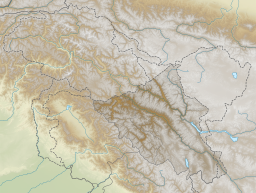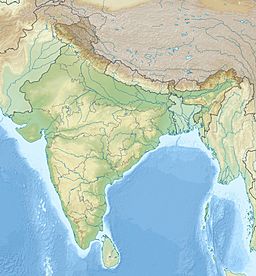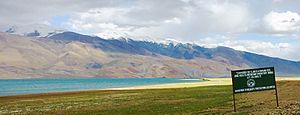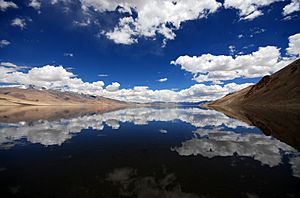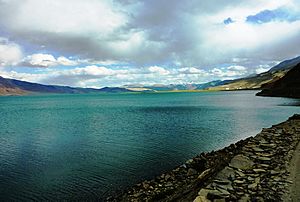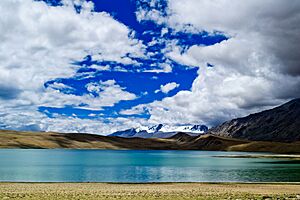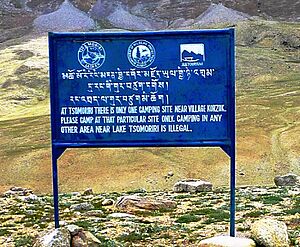Tso Moriri facts for kids
Quick facts for kids Tso Moriri |
|
|---|---|

View of the Lake
|
|
| Coordinates | 32°54′N 78°18′E / 32.900°N 78.300°E |
| Primary inflows | Snow Melt in summer |
| Designation | |
| Official name: Tsomoriri | |
| Designated: | 19 August 2002 |
| Reference #: | 1213 |
| Max. length | 19 km (12 mi) |
| Max. width | 3 km (1.9 mi) |
| Surface area | 13,500 ha (33,000 acres) |
| Max. depth | 105 m (344 ft) |
| Surface elevation | 4,522 m (14,836 ft) |
| Settlements | Korzok |
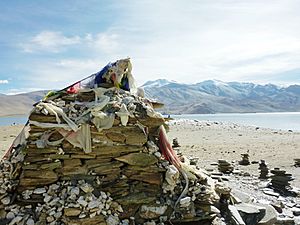
Tso Moriri, also known as Lake Moriri, is a beautiful "Mountain Lake" located in the high Changthang Plateau of Ladakh, India. This area is like a "northern plain" in the mountains. The lake and its surroundings are a special protected area called the Tso Moriri Wetland Conservation Reserve.
The lake sits very high up, at about 4,522 m (14,836 ft) above sea level. It is the largest high-altitude lake completely within Ladakh and India. The lake is about 26 km (16 mi) long from north to south and 3 km (1.9 mi) to 5 km (3.1 mi) wide.
Tso Moriri does not have any rivers flowing out of it. Its water is a bit salty, but you might not notice it by taste. The lake gets its water from melting snow in the nearby mountains and from natural springs. Most of the water comes from two main stream systems, which also have large marshy areas where they meet the lake.
It's usually easiest to visit the lake during the summer. However, the village of Korzok on the northwest shore and some military bases on the eastern side are lived in all year round.
Contents
Exploring Tso Moriri
The village of Korzok is a great place for visitors. It offers places to stay with local families, a Buddhist monastery, and activities related to the lake. Many tourists visit between May and September. Even though there are mostly tent camps and a small guesthouse, people still come to enjoy the beauty.
How Tso Moriri Was Formed
Lakes in the Himalayan mountains can be grouped by how they were made. Tso Moriri is a "remnant lake." This means it was once part of a much larger lake that formed due to movements in the Earth's crust. Over time, parts of that huge lake dried up, leaving behind lakes like Tso Moriri.
The Changthang Plateau, where the lake is, is a high-altitude area. It's an extension of the western Tibetan plateau and sits over 4,500 m (14,800 ft) high. This unique environment is home to many rare animals and plants. The lake's basin is a closed drainage basin, meaning water stays within it and doesn't flow out to rivers or oceans.
The lake is surrounded by tall mountains, some rising over 6,000 m (20,000 ft). These include Mentok Kangri and Lungser Kangri. The main people living here are the "Changpa" (or Champa). They are nomadic shepherds of yak, sheep, goat, and horses. They originally came from Tibet and use the valley for grazing their animals and for farming.
The Korzok Monastery, which is 400 years old, is on the western side of the lake. It attracts both tourists and Buddhist pilgrims. Northeast of Tso Moriri, there is a smaller lake known locally as the Lake of Joy.
Getting to the Lake
Tso Moriri is located southeast of Leh in eastern Ladakh. It's about 240 kilometres (150 mi) away by road, and the road is mostly in good condition. You can also reach Tso Moriri directly from Pangong Tso through the remote Changtang region. This drive is considered one of the most beautiful in all of Ladakh.
It's important to carry enough fuel because there are no petrol stations between Pangong Tso and Tso Moriri, which is about 235 kilometres (146 mi) away. Leh is also connected to many cities in India by air.
Water Features
The lake covers an area of about 120 km2 (46 sq mi). It is surrounded by peaks taller than 6,000 m (20,000 ft) on both its east and west sides. To the south, a flat valley connects to the Pare Chu river, but water does not flow between them.
Several small mountain streams feed the lake, including one that flows through pasture land. The lake gets its water from springs and melting snow. Its deepest point is about 40 m (130 ft). The area around the lake is a cold desert. In summer, temperatures range from 0° to 30 °C (32° to 86 °F). In winter, it can get very cold, from −10° to −40 °C (14° to -40 °F).
Animals and Plants
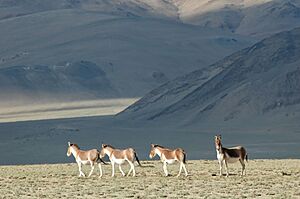
A study of the lake and its nearby Nuro Sumdo wetland in 1996 found many different animals and plants.
Birds of Tso Moriri
- Thirty-four types of birds live here, including 14 kinds of water birds. Some of these are rare or endangered:
- Black-necked cranes (Grus nigricollis) – these are endangered.
- Bar-headed geese (Anser indicus) – this is the only place in India where they breed.
- Brown-headed gulls (Larus brunnicephalus)
- Great crested grebe (Podiceps cristatus)
- Ferruginous pochard
- Black-necked grebe (Podiceps nigricollis)
Mammals of Tso Moriri
- Many mammals live around the lake, including:
- Tibetan gazelle (Procapra picticaudata) – also known as Goa antelope, a threatened species.
- Eurasian lynx
- Nayan (Ovis ammon hodgsoni)
- Bharal (Pseudois nayaur) – the Himalayan blue sheep.
- Tibetan Ass (Kiang) (Equus kiang) – a wild ass found only on the Tibetan Plateau.
- Great Tibetan Sheep
- Marmots (Marmota himalayana) – seen in large numbers on the hillsides.
- Hares (Lepus oistolus)
- Voles (Alticola roylei)
- Three types of mouse hares (Ochotona macrotis, Ochotona curzoniae or Tibetan sand fox, and Scincella ladacensis)
Large Predators
- Some large meat-eating animals found here are:
- The snow leopard (Uncia uncia)
- The Tibetan wolf (Canis lupus chanco)
Plants of Tso Moriri
While the deepest parts of the lake have no plants, the shallow areas have Potamogeton species. The marshy areas have many types of sedges and reeds, like Carex, Caragana, and Astragalus species. These plants are typical of the dry, steppe-like environment around the lake.
Other plants found include:
- Primula (a low-growing herb)
- Pedicularis (a parasitic plant)
- Juncus thomsonii
- Leontopodium species
- Tiny floating plants called phytoplankton, like Oocystis and Cyclotella (a type of diatom).
- Pastures for domestic animals to graze.
Ramsar Wetland Site
Because of its amazing variety of animals and plants, Tso Moriri was named a Ramsar Wetland site in November 2002. This means it's recognized internationally as a very important wetland.
The reasons for this include:
- It has unique and rare animal species.
- Many plant-eating animals found here are special to this region.
- The lake is a vital breeding ground and resting stop for many water birds during their long migrations. This shows how rich and productive the wetland is.
Protecting the Lake
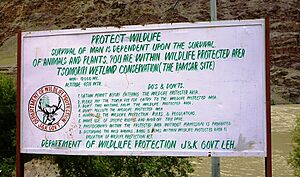
Tso Moriri faces several challenges that threaten its natural beauty and wildlife:
- More tourists visiting the lake can disturb the birds during their breeding season.
- New roads being built near the lake can also affect the environment.
- Too much grazing by sheep in the wetlands can harm the plants and animals.
- There isn't a good way to dispose of garbage at the lake, which can cause pollution.
- Dogs kept by people living near the lake sometimes attack cranes and destroy their eggs.
- Jeep safaris sometimes chase wild animals like kiangs and get too close to breeding areas.
- There aren't enough rules or monitoring by the government to protect the lake.
Conservation Efforts
People and organizations are working hard to protect the delicate ecosystem of Tso Moriri. Here are some of the things being done:
- Tso Moriri is officially a Wetland Reserve, and hunting wildlife is against the law.
- The State Department of Wildlife has set up a checkpoint near Mahe Bridge to monitor visitors entering the lake area.
- WWF-India (World Wildlife Fund – India) has an office in Korzok to help protect the high-altitude wetlands in Ladakh. They conduct surveys, talk to tourists, and teach locals about conservation.
- The Wildlife Institute of India has a research station in Leh to study the region.
- Nature clubs have been started, and information booklets about the lake have been published.
- Thanks to WWF-India's efforts, the local community declared Tso Moriri a "Sacred Gift for a Living Planet" in 2000.
- Traffic and parking around the lake have been reorganized, and camping sites are now limited.
- The Indo Tibetan Border Patrol (ITBP), tour operators, and local people regularly clean up garbage.
- The community in Korzok has built fences to protect the breeding and feeding grounds from vehicles.
- A Tso Moriri Conservation Trust has been created.
- Twenty Nature Clubs have been registered in different schools in Ladakh.
- The Indian Army has promised to help set up a Nature Interpretation Centre in Leh.
WWF's Role in Conservation
The World Wildlife Fund for Nature – India (WWF-India) is leading many efforts to protect Tso Moriri lake and the wider Ladakh region. WWF has been working here for over 30 years. Their main goal is to promote nature conservation and environmental protection to help the area develop in a fair and lasting way.
Some of their key activities for Tso Moriri and other wetlands in Ladakh include:
- Creating a plan for sustainable tourism that local communities can manage.
- Continuing to study the animals, plants, and human communities around the wetlands.
- Training tour operators, army personnel, teachers, and local communities about conservation.
- Running regular education and awareness programs for different groups of people.
- Developing management plans for Tso Moriri, Tsokar, and Pangong Tso lakes with the help of all involved parties.
- Setting guidelines for an Eco-Tourism Certification Scheme in Ladakh.
- Finding money to carry out a detailed environmental assessment.
- Developing and putting into practice Environmental Management Systems, especially for the tourism sector.
- Keeping and expanding their presence at Tso Moriri, Leh, and Tsokar, and increasing their presence at Chushul and Hanle marshes to achieve better results.
See Also
 In Spanish: Tso Moriri para niños
In Spanish: Tso Moriri para niños
Images for kids
-
Conservation in Tsomomiri Wetland Conservation, Jammu and Kashmir, India


